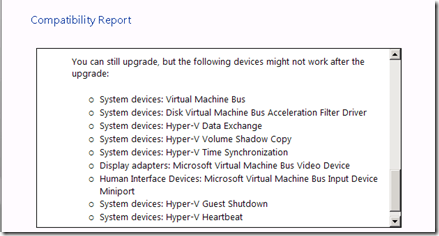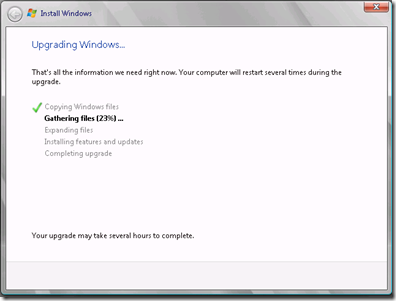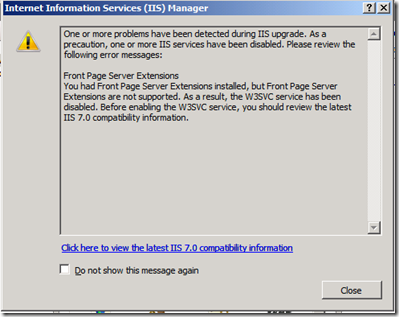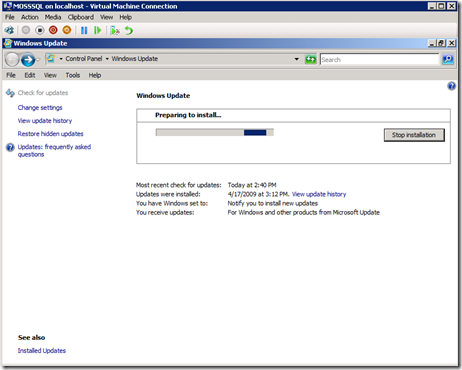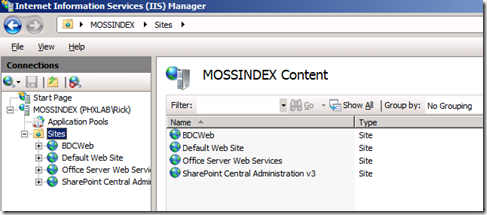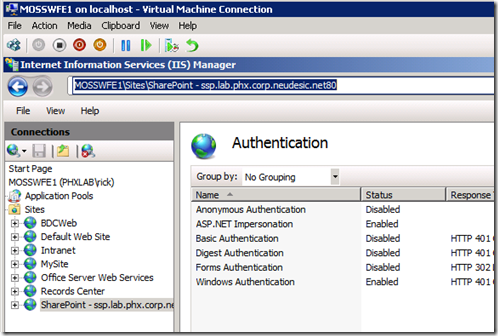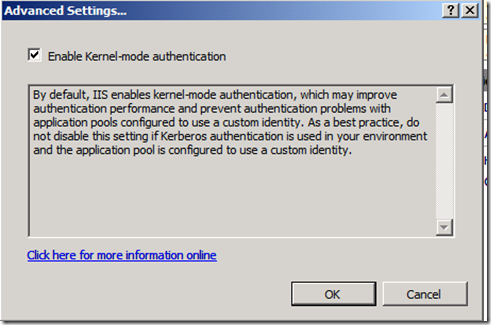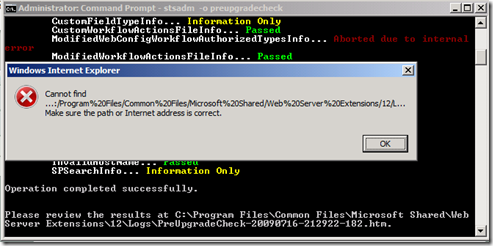A Triple Double Upgrade – PART 1
As most know, SharePoint 2010 has reached a few fortunate people in the world for them to get an advanced preview of it. The SharePoint Community is totally awash in buzz around it while trying to be true to their Non-Disclosure Agreement (NDA). Some, however, have exhibited irrational exuberance which resulted in them breaking their NDA. A lot of SharePoint experts are also “chomping at the bit” to get information out to the community to be the first to break the news about new features and best practices. Sigh…it’s a jungle out there, I tell ya.
*SO*—without breaking NDA, I will show you what to watch out for in an upgrade to SharePoint 2010; not only from MOSS 2007, but *also* from Windows 2003. Why? Because there are a lot of enterprises out there that have not fully upgraded to Windows Server 2008. I will venture to guess that most SharePoint farms are built on top of Windows Server 2003. I will also say that there is a significant amount of businesses that will need to use current hardware and upgrade rather than purchase NET NEW hardware. This means that they will need to not only upgrade SharePoint, but their operating system (OS) as well. I call this a Double. Small environments might have a three-server farm (2 Web Front Ends and 1 Application Server) and so there are three servers to be upgraded. This makes it a Triple Double.
In order not to violate NDA, I can only demonstrate a portion of the upgrade (hence PART 1). I will continue with PART 2 after other information has been released. Everything I will show you is authorized and has been in the public domain for a while.
I didn’t want to show you a perfect upgrade. It never happens. I hate going to conferences where the speaker shows you a demo and it goes flawlessly and the speaker doesn’t address issues that happen. Don’t get me wrong, a flawless demo is GREAT, but spend some time talking about what REALLY happens in the REAL WORLD.
That is what I will attempt to show you here. The issues I came across, and more importantly, the way that I fixed them. Let’s begin.
First, let’s start out with what I’m dealing with:
It’s pretty self-explanatory, except MOSSPPS is the Performance Point Server, and MOSSMS is the Exchange Server (Mail Server). The farm is MOSS 2007 SP1 sitting on top of Windows Server 2003 R2 x64.
First thing I want to do is see what I need to “fix” before I upgrade, right? So—I want to use STSADM –O PREUPGRADECHECK. BUT before I can use the preupgradecheck with STSADM, I will need to have SP2 installed. OK, let’s do it. I start the installation on all of the SharePoint servers.
Then I get to this point:
Now, typically you run this and stop right here for each server in the farm. You click 'OK' on the Application/Index server FIRST and THEN when its finished, you click 'OK' and do each individually.
And then I get this:
DOH!
OK, let’s take a look at the log and see what it says.
The log says that the SPTimerV3 failed to start.
A HA! I think I've found the issue…I tried to manually start the service and got a LOGON FAILURE.
Let's try it AGAIN….
Huh…ran the executable on WFE1 and it says it's already installed. Hmmm. Go to Control Panel and see this:
So now I'm curious what WFE2 says. So I go check. HA..only SP1. Rerun it on that server and…
NOW THAT’s MORE LIKE IT!! I run the hotfix with no issues. I check the license status to make sure it took, and I’m good.
So now the farm is running at SP2. Now I want to run -preupgradecheck parameter of STSADM and I get 'Access denied'. I am running as administrator. I wonder if I have to run as FARM ADMIN? So I run as a different Admin account…it works:
As expected, the OSPrequisite failed, which is “normal”. The resultant log file says:
OK, so let’s start an upgrade. I will begin with the Application server.
OK, the upgrade check told me the following:
So I go to Control Panel to uninstall Powershell and don't see it. Hmmm, wait -- I see a couple of Hotfixes with the Powershell logo on them…that must be it.
I BING the KB numbers and find out that they are indeed the Powershell installation features, but whoa--it also says:
Note By default, if Windows Server 2003 Service Pack 2 is installed on the system, PowerShell 1.0 cannot be uninstalled.
To resolve this issue, follow these steps:
- Follow the steps in the following Microsoft Knowledge Base (KB) article, 931941, to trust Windows PowerShell 1.0 that was introduced in KB926139:
931941 The Oobmig.exe tool is available to restore trust to out-of-band updates after you install Windows Server 2003 Service Pack 2
Note You may have to restart the computer. - Check whether the update can be uninstalled by using Control Panel. If the update cannot be uninstalled in this manner, uninstall PowerShell manually from the following location:
C:\WINNT\$NtUninstallKB926139$\spuninst\spuninst.exe
Note You may have to restart the computer.
OK, so let me try to uninstall the hotfixes. I cross my fingers...
Clicking on the Remove button brings up yet another warning dialog:
Fine, I'm going for it. I click YES.
SUCCESS! Now to deal with the other issues:
For this, I just need to stop the Search Service and I'm good. It's the next issue that puts the fear of God into me:
Great…HyperV issues…sigh….I'm going for it anyway.
OK, so this may take a while….I'll go do some other stuff while this churns.
Something to read *Before* you do an upgrade in the same reckless fashion I am doing it: https://technet.microsoft.com/en-us/library/cc755199(WS.10).aspx
So, after all of the servers are upgraded to Windows Server 2008, I attempt to open Central Admin and nothing happens. I mean, NOTHING. I go to IIS and receive this message:
OK, so I enable W3SVC and attempt again. It churns and churns and then gives me the "Cannot connect to the configuration database" message. OK…what's up NOW? I log on to the SQL server and see this:
DOH! OK, I'll wait…thanks.
OK..Now let me check and make sure Central Admin works. CHECK!
Shared Service Provider? FAIL!
Dang, NOW WHAT?
Hmmm, it works from the Application server, but not the WFE1, nor WFE2. hmmm…I'm getting the famous 401.1 error. Let me see if disabling LoopbackCheck does the trick. FAIL!
Hmmm… IIS 7 is *so* different….now where do I go to see where the issue. HEY! This is strange. I'm on the Application server and I see this:
WHERE IS THE SSP Web App???
Hmmm…now I go to the WFE:
Not only am I missing the SSP, but the Records Center, My Site, and Intranet web apps aren't there either! Ohhh..
Well…let's first find out what is going on with the 401.1 error.
So I go to the Advanced Settings for Windows Auth. Ahhh…this is the problem:
UNCHECK this box. Stupid IIS 7..
Do an IISRESET and…..
VOILA!!
Let me check WFE2
Same thing….ok…so for EACH web application you must DISABLE Kernel-mode authentication.
OK!! So, last thing…I will now run PREUPGRADECHECK on ALL of the servers in the farm. Here we go:
Nice…it finishes and I get this error
It's smoking dope…I find the file and open it up in a browser and everything is hunky dorey.
It tells me what options I have to upgrade:
OK. That checks out. This will be an Inplace Upgrade.
Stay tuned for Part II, where I will go through the steps of a medium farm inplace upgrade.
Comments
Anonymous
January 01, 2003
October 19 will be Part 2. NDA will be lifted on that day.Anonymous
July 21, 2009
Awesome post! Frustrating but a great journey. Unfortunately it does emphasize the complexity of the SharePoint stack. So many moving parts that have to all fit in the right place to work. Great job!Anonymous
July 23, 2009
Very good and clear piece of work. I enjoyed your story. Thank you for sharing these possible pitfalls. This one goes into my favorites...Anonymous
July 23, 2009
Great post! I'm sure we can create a list of what not to do's using this post :) Thanks!Anonymous
August 04, 2009
Think the requirement for Win2k8 and Sql2k8 will be a huge thing for a lot of enterprises who just spent a fortune on their current infrastructure. So posts like this al really helpful because most of us will face these issues.. So thanks already! ;)Anonymous
September 23, 2009
Great post, when will you have Part 2 up?




![clip_image001[5] clip_image001[5]](https://msdntnarchive.z22.web.core.windows.net/media/TNBlogsFS/BlogFileStorage/blogs_technet/ritaylor/WindowsLiveWriter/ATripleDoubleUpgradePART1_C061/clip_image001%5B5%5D_thumb.png)



![clip_image001[7] clip_image001[7]](https://msdntnarchive.z22.web.core.windows.net/media/TNBlogsFS/BlogFileStorage/blogs_technet/ritaylor/WindowsLiveWriter/ATripleDoubleUpgradePART1_C061/clip_image001%5B7%5D_thumb.png)



